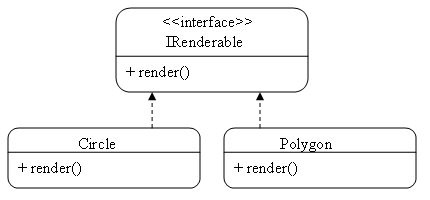CSC/ECE 517 Fall 2010/ch5 5c ck
Introduction
Dynamic dispatch means there is a determination of which method to execute at run time, when a class and one of it's subclasses have the same method signature. Evaluation of Control Structures for Dynamic Dispatch in JAVA (pg 5)[1]
This occurs when a class is downcast to one of its super classes and a method is called on that super class object.
Generic Example
Using Dynamic Dispatch
We have a set of objects that can be rendered to the display.
Each object implements the IRenderable interface as seen below:

Utilizing the ability of dynamic dispatch it is very simple to render a collection of IRenderable[] objects for the display:
IRenderable[] irCollection = {new Circle(0,0,.5), new Polygon(0,0,1,1,2,2,0,0)}
foreach (IRenderable ir in irCollection)
{
ir.render();
}
Note: This example would be the same if IRenderable were a class or abstract class object.<br/
Static Simulation of Dynamic Dispatch
Without dynamic dispatch we would have to test the type of the object, cast it to a subtype and make the call.
IRenderable[] irCollection = {new Circle(0,0,.5), new Polygon(0,0,1,1,2,2,0,0)}
foreach (IRenderable ir in irCollection)
{
if (ir is Circle) ((Circle)ir).render();
if (ir is Polygon) ((Polygon)ir).render();
}
This is more complicated than using dynamic dispatch and it also requires us to alter this code every time we add a new class.
Single and Multiple Dispatch
Single Dispatch
All Object Oriented languages use a dynamic dispatch process known as single dispatch.
In single dispatch only one object is accessed dynamically at run time.
The source object is the only one that is accessed at run time, all parameters are treated as static types.
Multiple Dispatch
A few Object Oriented languages use a more complete dynamic dispatch process known as multiple dispatch.
In multiple dispatch more than one or all objects are accessed dynamically at run time.
The source object is accessed at run time, and one or more parameters are dynamically accessed at run time.
Performance
According to Technical Report on C++ Performance (pg 26)[4] "Calling a virtual function is roughly equivalent to calling a function through a pointer stored in an array"
Conclusion
References
[1] Evaluation of Control Structures for Dynamic Dispatch in Java by Inira Lorraine and Karel Drieson(pg 5)
[4] Technical Report on C++ Performance ISO/IEC TR 18015:2006(E) 2006-02-15 (pg. 26)